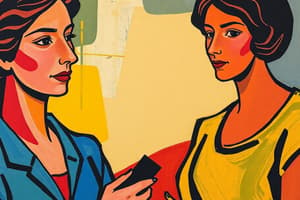Podcast
Questions and Answers
What were some activities that women engaged in for reform during the late 19th and early 20th centuries?
What were some activities that women engaged in for reform during the late 19th and early 20th centuries?
- Participating in anti-British struggles
- Editing magazines and founding schools (correct)
- Running for political office
- Exploring space missions
Why were some Hindu nationalists and orthodox Muslims concerned about the changes in women's behavior?
Why were some Hindu nationalists and orthodox Muslims concerned about the changes in women's behavior?
- They wanted women to have more freedom
- They believed it would bring prosperity to their society
- They feared it would lead to corruption of Hindu culture (correct)
- They thought it would increase religious tolerance
What was one of the demands that women's political pressure groups pushed for in the early 20th century?
What was one of the demands that women's political pressure groups pushed for in the early 20th century?
- Tax exemptions for women
- Right to own land
- Female suffrage (correct)
- Freedom of speech for all citizens
Which prominent leaders supported demands for greater equality and freedom for women in the 20th century?
Which prominent leaders supported demands for greater equality and freedom for women in the 20th century?
What did Tarabai Shinde question in her book, Stripurushtulna?
What did Tarabai Shinde question in her book, Stripurushtulna?
What did nationalist leaders promise regarding suffrage after Independence?
What did nationalist leaders promise regarding suffrage after Independence?
What was one of the concerns that many people had about schools for girls in the mid-nineteenth century?
What was one of the concerns that many people had about schools for girls in the mid-nineteenth century?
How did most educated women in the nineteenth century receive their education?
How did most educated women in the nineteenth century receive their education?
In which region were schools for girls established by the Arya Samaj during the latter part of the nineteenth century?
In which region were schools for girls established by the Arya Samaj during the latter part of the nineteenth century?
What did aristocratic Muslim households in North India primarily teach women to read?
What did aristocratic Muslim households in North India primarily teach women to read?
Which reformer reinterpreted verses from the Koran to advocate for women's education?
Which reformer reinterpreted verses from the Koran to advocate for women's education?
When did the first Urdu novels start to be written?
When did the first Urdu novels start to be written?
What was one of Raja Rammohun Roy's main goals in spreading Western education in India?
What was one of Raja Rammohun Roy's main goals in spreading Western education in India?
In the pre-printing age, how were social customs and practices discussed when books were not easily available?
In the pre-printing age, how were social customs and practices discussed when books were not easily available?
Which term best describes Raja Rammohun Roy's approach towards societal changes?
Which term best describes Raja Rammohun Roy's approach towards societal changes?
What did Raja Rammohun Roy criticize regarding the treatment of women in society?
What did Raja Rammohun Roy criticize regarding the treatment of women in society?
What was a common theme among the discussions initiated by Indian reformers like Raja Rammohun Roy?
What was a common theme among the discussions initiated by Indian reformers like Raja Rammohun Roy?
Why did people like Raja Rammohun Roy engage in debates and discussions in the new cities?
Why did people like Raja Rammohun Roy engage in debates and discussions in the new cities?
Flashcards are hidden until you start studying
Study Notes
Women's Reform Movement in India
- By the end of the 19th century, women themselves were actively working for reform, writing books, editing magazines, founding schools and training centers, and setting up women's associations.
- They formed political pressure groups to push for laws on female suffrage, better healthcare, and education for women from the early 20th century.
Opposition to Women's Reform
- Many Hindus and Muslims were worried about the impact of Western influences on their cultures and family values.
- They believed that women adopting Western ways would corrupt their cultures and erode family values.
Support for Women's Reform
- Leaders like Jawaharlal Nehru and Subhas Chandra Bose supported demands for greater equality and freedom for women.
- Nationalist leaders promised that there would be full suffrage for all men and women after Independence.
Education for Women
- Many reformers believed that education for girls was necessary to improve the condition of women.
- Schools for girls were established by reformers like Vidyasagar in Calcutta and Jyotirao Phule in Maharashtra.
- Initially, many people opposed education for girls, fearing it would take them away from home and lead to corruption.
Notable Figures
- Tarabai Shinde wrote about the inequalities faced by women in her book, Stripurushtulna.
- Rashsundari Debi secretly learned to read and write in the flickering light of candles at night.
- Raja Rammohun Roy founded the Brahmo Sabh (later Brahmo Samaj) to bring about social change and promote Western education in the country.
Studying That Suits You
Use AI to generate personalized quizzes and flashcards to suit your learning preferences.




